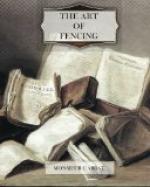A good Disposition is seldom to be met with, for there is generally a Mixture of bad Parts with the good. Some have a supple, light and vigorous Body, and with these Qualities a heavy or ill adjusted Hand; and others that have as good a Disposition as is desirable, have a narrow Genius, fearing to undertake any thing, or are hot and inconsiderate, which shews that it is only be a perfect Accord of the Parts and Understanding that a Man can be perfectly dexterous.
In short an able Master does not only shew the Fault, and whence it proceeds, but also the Danger to which it exposes, and the Means to leave it. A Master whose Play is regular, or who has the best Foundation, may properly be said to be a good Master.
CHAP. XXX.
Rules for pushing and parrying at the Wall, and for making an Assault.
Though ’tis absolutely necessary to begin by way of Lesson, and to continue in it a long Time, in order that Practice growing to a Habit, may give Liberty to the Parts to form themselves: nevertheless however well you may take your Lessons, some other Means are necessary to make an Assault well, than those which the Master gives at his Plastron: This Rule must be supported by pushing and parrying at the Wall, and in the Manner I am going to lay down.
When you have laboured a certain Time at Lessons, you must push at a Cushion which is fixed against the Wall for that Purpose, observing the Guard, and the Measure or Extention of the Thrust; and that the Hand display itself in Quart, not only according to the Rule, but first, adjusting and supporting the Thrust, and that all the Parts be placed in the most advantageous Situation for the Thrust and Recovery, which shou’d be very regularly observed.
After having lunged for some Days on the Cushion, to fix the Wrist and Body a little, you must push at a Scholar, who Being placed at the Wall will parry your Thrusts; you shou’d be in Measure, and to see if it be just, you must lunge in Quart, placing the Button softly on the Body, at the same time taking off your Hat, having taken the Measure you must recover in Guard, and place yourself on the Outside of his Sword in order to disengage and push Quart, being more careful of pushing justly than hitting; he that parrys shou’d from time to time drop his Foil, which will shew whether he that pushes follows the Blade or the Line of the Body; having remain’d some Time upon the Lunge to form the Support of the Wrist and the Posture of the Body you recover to Guard. When you lunge pretty well in Quart, you may disengage and push Tierce, and when the Thrust is pushed and parryed, you may recover and push Seconde under.
When you have pushed for some Time in this Manner, you may practise to parry, putting yourself for that Purpose to the Wall, which furnishes a better Parade than at large, where you are used to draw back the Body which weakens it, whereas here you cannot, which makes the Parade stronger, having no Dependence but on the Foil; you shou’d chuse a Scholar that pushes the most regularly, it being difficult without that, that a Beginner shou’d learn to parry justly.




